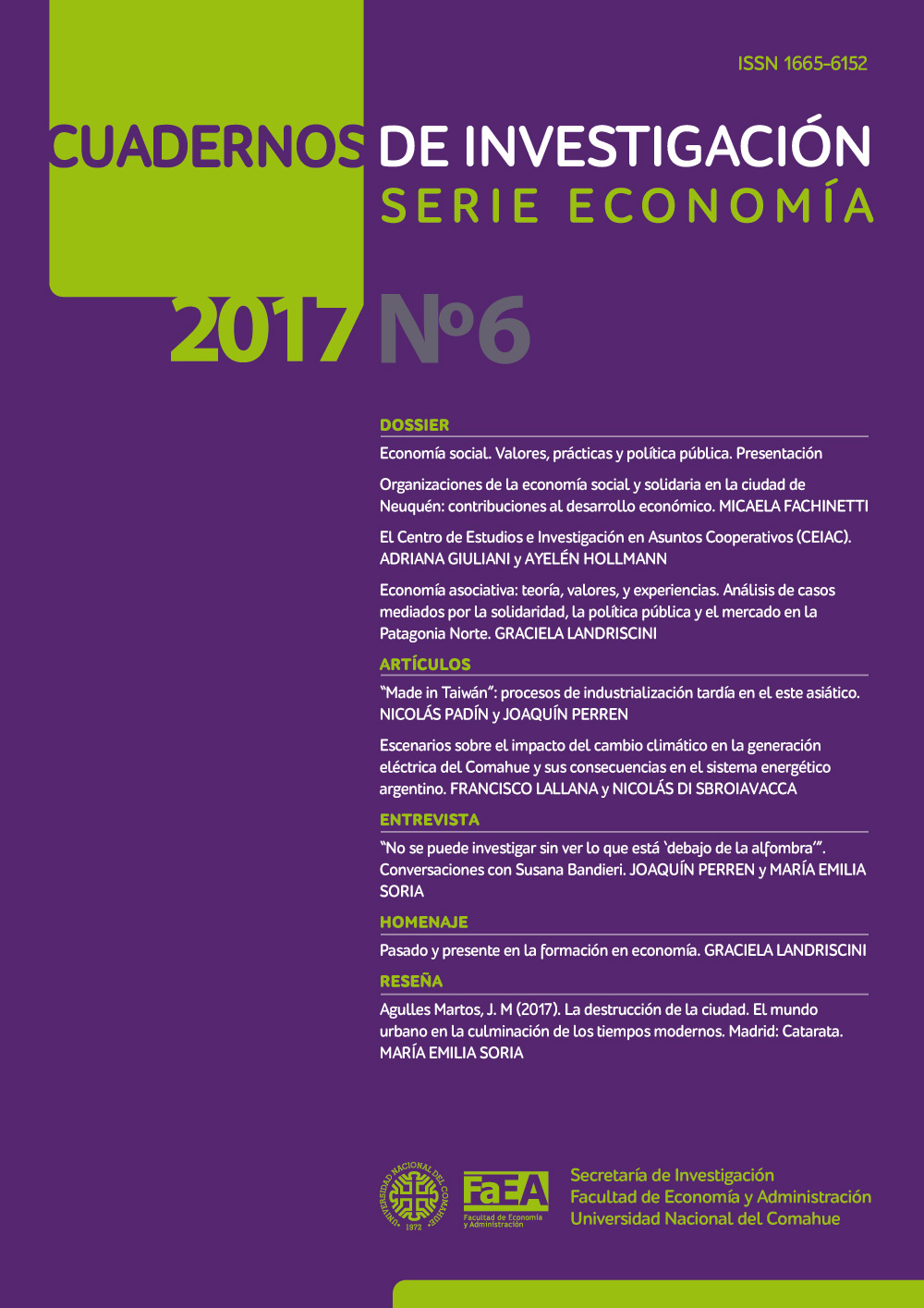“MADE IN TAIWÁN”: Procesos de industrialización tardía en el este asiático
Keywords:
New Industrializated Conuntries, Estate, Market, high-tech industries, Taiwán.Abstract
The analysis of asian industrialization experiences from the second half of the 20th century, focusing our interest on the island of Taiwan, is a suggestive platform to renew the analytical efforts on the problem of economic development and industrialization. In East Asia, although the market plays a basic role in the allocation of resources, the State maintains the general orientation of the economic process, controlling and supervising the main variables, with a determined policy of export promotion, in a synergy between the State and market, much more than in reciprocal competition approaches. The remarkable success of these economies originated under the convergence of several factors. The orientation of a "hard" State, capable of overcoming sectoral pressures and of combining free trade, with protectionism, was crucial, adopting a path of development that sought strategic integration to the world market, although not subordinated to the dictates of the countries central capitalists. For this, these economies were actively integrated into the new strategy of industrial relocation to the periphery undertaken by the large multinationals starting in 1970, officiating as apprentices first and promoting endogenous development and innovation afterwards. Taiwan illustrates the parable developed in the region, as a revealing example of the economic dynamism of the Asia-Pacific area: indicating, in the beginning, the origin of products of dubious quality, scattered throughout the world, to its constitution as one of the Asian champions in the production of technological goods with high added value.Downloads
References
AMSDEN, A. (2004). “La sustitución de importaciones en las industrias de alta tecnología:Prebisch renace en Asia”. Revista de la CEPAL, Nº 82.
AMSDEN, A., HIKINO, T. y WOLFSON, L. (1995). “La industrialización tardía en perspectiva histórica”. Desarrollo Económico, Vol. 35, Nº 137.
BARBERO, M. I. et al. (2007) Historia Económica Mundial. Del Paleolítico a Internet, Emecé, Buenos Aires.
BEKERMAN, M. y SIRLIN, P. (1997). “Política económica e inserción internacional de Taiwan”. Revista Comercio Exterior, Vol. 47, Nº 6, México.
BEKERMAN, M., SIRLIN, P. y STREB, M. L. (1995). “El “milagro” económico asiático: Corea, Taiwan, Malasia y Tailandia”. Revista Comercio Exterior, Banco Nacional de Comercio Exterior, Vol. 45, Nº 4, México.
CAMERON, R. (1996) Historia Económica Mundial. Desde el Paleolítico hasta el Presente, Alianza, Madrid.
CHANDLER, A. (2008) La mano visible. La revolución de la gestión en la empresa norteamericana, Ediciones Belloc, Barcelona.
GALBRAITH, J. (1999) Historia de la economía, Ariel, Buenos Aires.
GERSCHENKRON, A. (1968) El atraso económico en su perspectiva histórica. Ariel, Barcelona.
HOUTART, F. (2002). “Los NICs: “modelos” para (des)armar”. Temas, Nº 29, Cuba.
JUNG TZO L. (2008). “El desarrollo económico y tecnológico de Taiwán”. Perspectiva, N°53, edición 10.
KAY, C. (2002). “Reforma agraria, industrialización y desarrollo: ¿Por qué Asia Oriental superó a América Latina?”. Debate agrario: análisis y alternativas, Centro Peruano de Estudios Sociales, Lima.
MADDISON, A. (1998) Historia del desarrollo capitalista. Sus fuerzas dinámicas. Una visión comparada a largo plazo, Ariel, Barcelona.
MARX, C. y Engels, F. (2000) Manifiesto Comunista, El Aleph, Buenos Aires.
MORISHIMA, M. (1984) ¿Por qué ha triunfado Japón?, Crítica. Barcelona.
NORTH, D. (1984) Estructura y cambio en la historia económica, Alianza, Madrid.
PEEMANS, J. P. (1988). “El sudeste asiático entre el mito y la realidad”. Cuadernos de Economía, Volumen 9, N° 12, pp. 21-55, Universidad Nacional de Colombia, Bogotá.
PERREN, J., TEDESCHI CANO, G. y CASULLO, F. (2014) De pioneros, seguidores y descolgados. Industria y crecimiento económico en el siglo XIX, EDUCO, Neuquén.
TORIJA ZANE, E. (2012). “Desarrollo industrial y política macroeconómica de los dragones asiáticos”. Documentos de Trabajo, CEPAL-BCRA, Santiago de Chile.
TOUSSAINT, E. (2006) Banco Mundial. El golpe de Estado permanente. La agenda oculta del Consenso de Washington, El Viejo Topo, España.
SEVARES, J. (2010) Por qué crecieron los países que crecieron, Edhasa, Buenos Aires.
SCHUMPETER, J. (1961) Capitalismo, socialismo e democracia, Editora Fundo de Cultura, Rio de Janeiro.
STIGLITZ, J. (1997). “Algunas enseñanzas del milagro del este asiático”. Desarrollo Económico”, Nº 147, Buenos Aires.
VILAS, C. (2002). “La piedra en el zapato: Estado, instituciones públicas y mercado”, En: CAMPOS ARAGÓN, L. (Coord.), La realidad económica actual y las corrientes teóricas de su interpretación, UNAM, México.
WEBER, M. (1979) La ética protestante y el espíritu de capitalismo. Premia Editores, México
Downloads
Additional Files
Published
How to Cite
Issue
Section
License
Licencia: Compartir - copiar y redistribuir el material en cualquier medio o formato.
La licenciante no puede revocar estas libertades en tanto usted siga los términos de la licencia.
https://creativecommons.org/licenses/by-nc-nd/2.5/ar/






